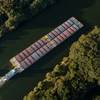Latin American Ports Cargo Throughput Rose 7.7%
Container throughput in ports of Latin America and the Caribbean increased by 7.7% in 2018 in comparison with the previous year.
According to the Economic Commission for Latin America and the Caribbean (ECLAC), this analysis is based on the performance of a sampling of 31 countries and 118 ports and port areas in the region.
According to the annual report unveiled by the United Nations organization – which was called “port ranking” in prior years – the data largely maintained the heterogeneity seen in throughput behavior in previous periods, both in reference to ports and countries. Of the total sample, 66 ports and port areas saw their figures improve versus 2017.
The total volume of activity in 2018 exceeded 53.2 million TEU which represents 7.1% of global throughput, marking a slight increase in the rate versus the previous year (when it amounted to 6.6% of global throughput), according to ECLAC.
The ten countries contributing the most to the total volume of cargo handled represented 84.1% of regional movement. These are (from highest to lowest based on the quantity of TEU mobilized): Brazil, Mexico, Panama, Colombia, Chile, Peru, Argentina, Ecuador, the Dominican Republic and Jamaica.
According to the data of the sampling compiled by ECLAC, in 2018 the East Coast of South America (ECSA) recorded a 12% increase in the activity of ports and port areas, measured in terms of volume. Meanwhile, the West Coast of South America (WCSA) continued with a slight upward trend, growing 7% in 2018, compared with the 6% seen between 2016 and 2017.
The Caribbean showed 12% growth in total throughput, while Central America (without including Mexico) had more subtle growth of 7% only on the West Coast, since the East Coast essentially maintained the same activity levels as in 2017.
The Gulf of Mexico area grew 8% versus 2017, and Pacific Mexico 11%. Panama, meanwhile, experienced growth on its Caribbean coast (11%) with regard to the country’s total throughput, while its Pacific coast registered a decline of -16%.










